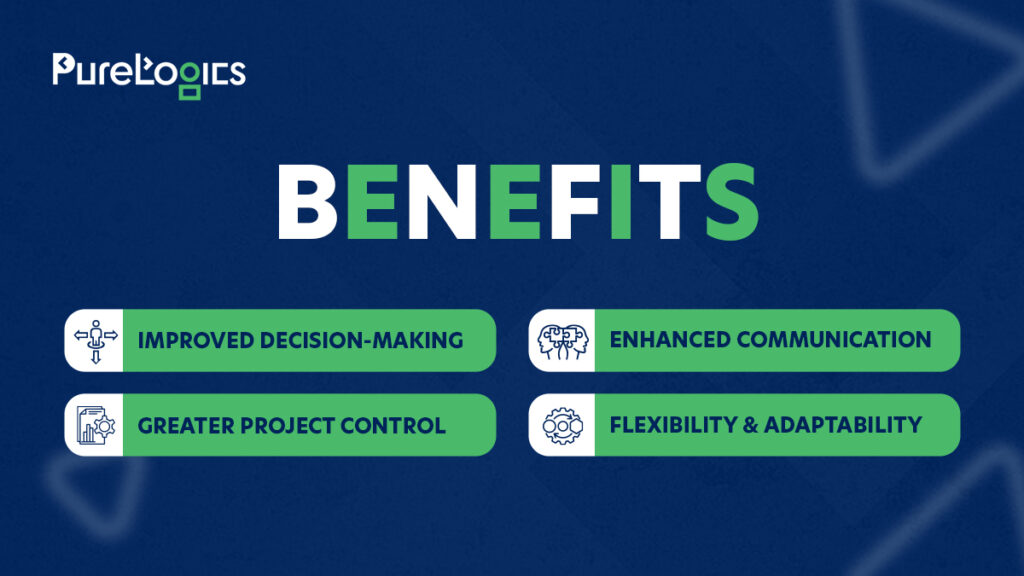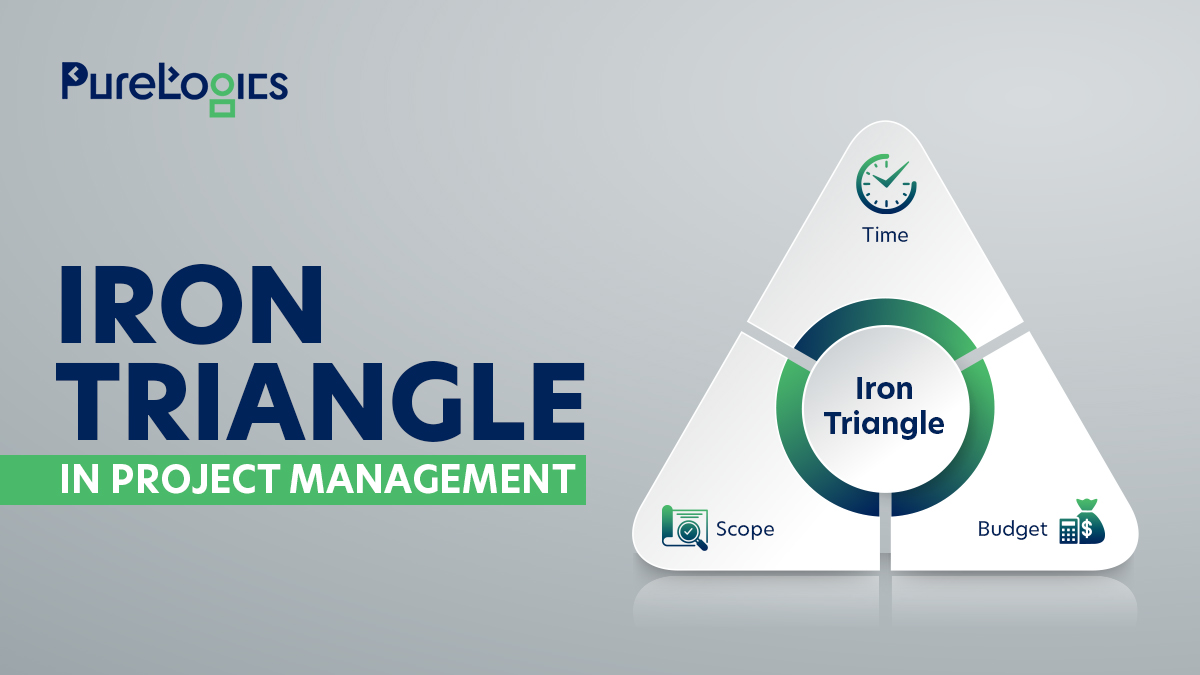A project or any time-based initiative is viewed as a blend of three constraints:
- Time
- Scope
- Budget
Together, these three constraints form an iron triangle. It is the heart of every project, and every project manager must be adept at balancing these constraints.
In this blog post, we have discussed what actually a project management triangle is, its importance, benefits, and strategies to manage this important iron triangle. So, without any further ado, let’s dive into the topic!
Understanding the Project Management Triangle
The project management triangle (also known as iron triangle, project triangle, and triple constraint) is a concept that applies to all projects. The project management triangle has three sides. Every side represents one of the constraints to deliver a project successfully. As mentioned above, the three sides are scope, time, and budget.
The purpose of Project Triangle is to display that these three variables are interrelated. If you increase the project scope, you will also need more time and budget to complete it. Similarly, if you decrease the amount of budget, the project scope and time will also automatically narrow down.
Time: It represents the complete schedule for the project. It also includes deadlines and overall time to conclude the project.
Scope: It includes the project’s goals and all the tasks that you will perform to complete the project.
Budget: It refers to the financial resources. It includes material costs, labor cost, and all other expenses.
Contact Us Today
Get in touch to learn more about our services and how we can help you.
Importance of the Iron Triangle
The iron triangle holds significant importance in project management. It provides you with a framework to understand the trade-offs you need to make. If you manage these three variables efficiently, it is sure that your project will be completed successfully. In essence, the triangle helps you make realistic expectations and informed decisions.
Risk Management: The iron triangle identifies all the possible risks early in the project. Once you manage to understand the variables of the iron triangle, you make all the strategies to deal with predicted challenges. Let’s understand it with an example. If your project runs behind schedule, you may find it appropriate to decrease its scope or request to add more budget.
Quality Assurance: Iron triangle also ensure the quality in the project by balancing all three variables. It doesn’t allow you to focus on only one or two variables and let the third variable unnoticed. It helps you manage all the three constraints effectively so that you can deliver high-quality output.
Client Satisfaction: You know that meeting client expectation is the most essential aspect. Thanks to Iron Triangle in project management! It helps you meet the client’s expectations by balancing all three constraints of the project – time, scope, and budget.
Benefits of Managing the Iron Triangle

Improved Decision-Making
Understanding the trade-offs between time, scope, and budget allows project managers to make better decisions. They can prioritize tasks, allocate resources effectively, and manage risks proactively. For example, if a project is falling behind schedule, the project manager might decide to allocate more resources or reduce the scope to meet the deadline.
Enhanced Communication
The Iron Triangle provides a common language for discussing project constraints with stakeholders. It helps clearly communicate the impact of changes in one area on the other two areas. When stakeholders understand the trade-offs, they are more likely to support necessary adjustments and collaborate effectively.
Greater Project Control
By continuously monitoring and adjusting the three constraints, project managers can maintain better control over the project’s progress and outcomes. This leads to more predictable project delivery and higher satisfaction among stakeholders. For example, regular status updates and progress reports keep everyone informed and allow for timely interventions when needed.
Flexibility and Adaptability
Managing the Iron Triangle effectively provides the flexibility to adapt to changing circumstances. Projects often encounter unexpected challenges or opportunities. With a solid understanding of the constraints, project managers can quickly adjust plans and resources to accommodate changes without compromising the overall objectives.
Contact Us Today
Get in touch to learn more about our services and how we can help you.
Strategies for Managing the Iron Triangle
Here are some tried-and-tested strategies to manage the iron triangle:
Setting Clear Objectives
At the outset of the project, it is essential to define clear and achievable objectives. This involves understanding the project requirements and constraints and setting realistic goals that align with the available time, scope, and budget. Objectives should be specific, measurable, achievable, relevant, and time-bound (SMART).
Effective Planning
Detailed planning is key to managing the Iron Triangle. This includes developing a comprehensive project plan that outlines the tasks, timelines, resources, and budget. It also involves identifying potential risks and developing mitigation strategies. A well-thought-out plan serves as a roadmap for the project, guiding the team through each phase and ensuring that all constraints are considered.
Regular Monitoring and Reporting
Continuous monitoring of the project’s progress is crucial. This involves tracking key performance indicators (KPIs) related to time, scope, and budget and regularly reporting the status to stakeholders. Any deviations from the plan should be addressed promptly to keep the project on track. Tools such as Gantt charts, dashboards, and project management software can aid in monitoring and reporting.
Change Management
Changes are inevitable in any project. Implementing a robust change management process helps assess the impact of changes on the Iron Triangle and make informed decisions. This includes evaluating the necessity of changes and their impact on the project constraints, as well as communicating the changes to all stakeholders. A formal change request process ensures that all changes are documented, reviewed, and approved before implementation.
Resource Allocation
Efficient allocation of resources is vital for balancing the Iron Triangle. This involves assigning the right people with the right skills to the right tasks, and ensuring that resources are utilized optimally. It also includes managing the availability of resources and addressing any resource constraints proactively. Resource leveling and resource smoothing techniques can help in optimizing resource allocation.
Stakeholder Engagement
Engaging stakeholders throughout the project lifecycle is essential for managing the Iron Triangle. Regular communication with stakeholders ensures that their expectations are understood and managed. It also helps them gain their support for necessary changes and secure additional resources when needed. Stakeholder analysis and engagement plans can aid in identifying and managing stakeholder expectations.
Risk Management
Proactively identifying and managing risks is critical for maintaining the balance of the Iron Triangle. This involves conducting risk assessments, developing risk mitigation plans, and regularly reviewing risks throughout the project. Contingency plans and reserves can be included in the budget to address unforeseen challenges without derailing the project.
Quality Management
Ensuring that the project meets quality standards is essential for balancing the Iron Triangle. This involves setting quality criteria at the beginning of the project and conducting regular quality checks throughout the project lifecycle. Quality assurance and quality control processes help in maintaining the desired quality levels without compromising on time or budget.
Conclusion
Effective management of the Iron Triangle not only leads to successful project outcomes but also enhances the project manager’s ability to handle complex projects and deliver value to stakeholders. By setting clear objectives, planning meticulously, monitoring progress, managing changes, allocating resources efficiently, engaging stakeholders, managing risks, and ensuring quality, project managers can navigate the challenges of the Iron Triangle and deliver projects that meet or exceed expectations.
We offer a free 30-minute consultation call. Give us a call, and discuss your project with PureLogics.


 [tta_listen_btn]
[tta_listen_btn]
 July 22 2024
July 22 2024





